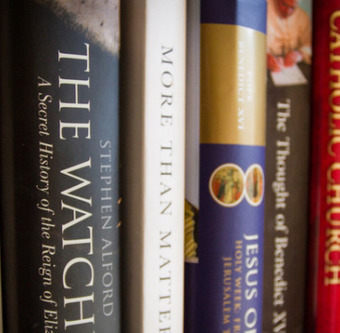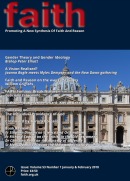
Book Review - Explaining and meditating on the Mass
The Bible and the Mass, by Rev. Peter Stravinskas, Newman House Press, 96 pp, £9.47 UK, $12.00 USA.
reviewed by Sister Mary Dominic Pitts
One would be hard pressed to find a book about the Mass and its relationship with Sacred Scripture as thorough as the fourth edition of The Bible and the Mass. In a modest eighty-seven pages (followed by Appendices on liturgical colours, vestments, objects used in worship, and the use of Latin in the liturgy), Rev. Peter Stravinskas covers every detail of the Mass from the Entrance to the Concluding Rites with facts and explanations, often surprising, about the Scriptural origins and contemporary celebration of the Eucharistic liturgy.
Clear information
Stravinskas has made changes both in the appearance and the text of The Bible and the Mass since his 1989 original. The cover of the fourth edition now depicts Jan van Eyck’s Adoration of the Mystic Lamb. The author has simplified the Table of Contents so that it lists only the four main chapters, saving the subdivisions for the beginning of each chapter, closer to their explanations. Scripture quotations are indented with wider margins, making it easier to tell them from the text. Divine names and pronouns are capitalized out of reverence. Changes in the rubrics are noted—the antiphon of the day takes precedence over a hymn in “[establishing] the mood for the particular day’s celebration”. Some new rubrics are shown to revert to the original, more accurate word: “Collect” is once again used instead of “Opening Prayer”. On the other hand, clear, well-worded information from the 1989 edition is retained. For example, the author had already explained occasions when the altar is incensed and the significance of the congregation’s postures: sitting, for example, to “listen attentively,” and standing “out of respect” when the Gospel is read.
Enhancing the meaning
As the title The Bible and the Mass of the book indicates, Stravinskas quotes Scripture as well as some of the new Mass texts where they apply to his explanatory narrative. He also includes numerical references, often two or three on a page, to sections of the Catechism of the Catholic Church (not yet published when Stravinskas wrote his original 1989 edition) that enhance the theological meanings of the rite under discussion. Then he follows the main chapter with five or six more short quotations from the new texts expanded with a short meditation or spiritual response. The author ends every chapter with these “Scriptural Meditations” and five discussion questions on the chapter material for Scripture study groups.
The perfect and acceptable sacrifice
Stravinskas’ very chapter titles are meditations: Chapter One, “Coming into His Presence” describes the Entrance Rites in detail. Chapter Two, “God Speaks to Us”, explains the cycle of readings and the histories of the Creed and the General Intercessions. Chapter Three, “The Perfect and Acceptable Sacrifice”, includes the relationship of the altar to sacrifice, the presentation and blessing of the gifts, and the traditional eastward orientation of churches because Christians expected the Second Coming from the rising sun.
However, most of Chapter Three is dedicated to the four Eucharistic Prayers. Their placement before the Communion Rite is the same, but each has a unique focus. Prayer One intercedes for the whole Church in a particular way. The ancient Second Prayer highlights the epiclesis, the beseeching of the Holy Spirit to transform the gifts, and the anamnesis, the “memorial . . . linked to the Lord’s Paschal Mystery”. Prayers Three and Four, modern in composition, highlight Salvation History and the unity of the Church.
Communion
Chapter Four, “Receiving the Lord and Sent Forth to Serve”, notes that “the English word ‘communion’ [comes from] the Greek koinonia,”—a unity in fellowship. The author uses the image of a cross—the “vertical and horizontal dimensions of Communion”—to lead into the Lord’s Prayer and to show this intimate prayer incarnated in the Sign of Peace with one’s neighbour. The Sign of Peace is shown to derive from the Lord’s “Peace be with you” on Easter night (Stravinskas notes the irony of contemporary disagreements about giving it). There is great theological depth in the section on the Communion rite, including the separate consecrations and reuniting of the Body and Blood, and the Scriptural invitation to the “wedding feast of the Lamb” (Rev. 19:9). Nevertheless, the rest of the section is weighed down with several pages of technicalities about intercommunion, Eucharistic ministers, reception on the hand or tongue, and whether both species should be offered. These restrictions no doubt need to be included, but they might be less distracting in the Appendix. Fortunately, the beautiful Scriptural Meditations such as “Behold the Lamb of God” and “Bow down for the blessing” end Chapter Four as the Paschal Mystery deserves.
14,000 Scripture verses
Particularly attractive are the frequent histories of many parts of the Mass. These include early worship in the catacombs in Rome, the modeling of the three-year cycle of readings in Jewish synagogues, and the necessity of inserting the Nicene Creed into the Mass. Also interesting are the difference between a homily and a sermon, what should be brought up (or not) in an offertory procession, and why the Eucharistic bread is called a host. There are unexpected facts: if a person were to go to daily Mass for two years, he would hear 14,000 Scripture verses!
There is no doubt that Stravinskas has been pondering the Mass for his entire priestly life. He knows the Vatican II documents on Scripture and the liturgy; he obviously continues to study and to refresh his insights with additional research into the Mass and its theology as laid out in the Catechism. However, The Bible and the Mass is not a theological treatise. It is intended to be accessible to readers, who will enjoy the historical explanations, the description of the rites as they should be done, clarifications where options differ, and most of all, I think, the meditations on key texts in the beautiful new translation.
Notes:
Sister Mary Dominic Pitts O.P. is a Dominican Sister of the Congregation of Saint Cecilia in Nashville, Tennessee.





